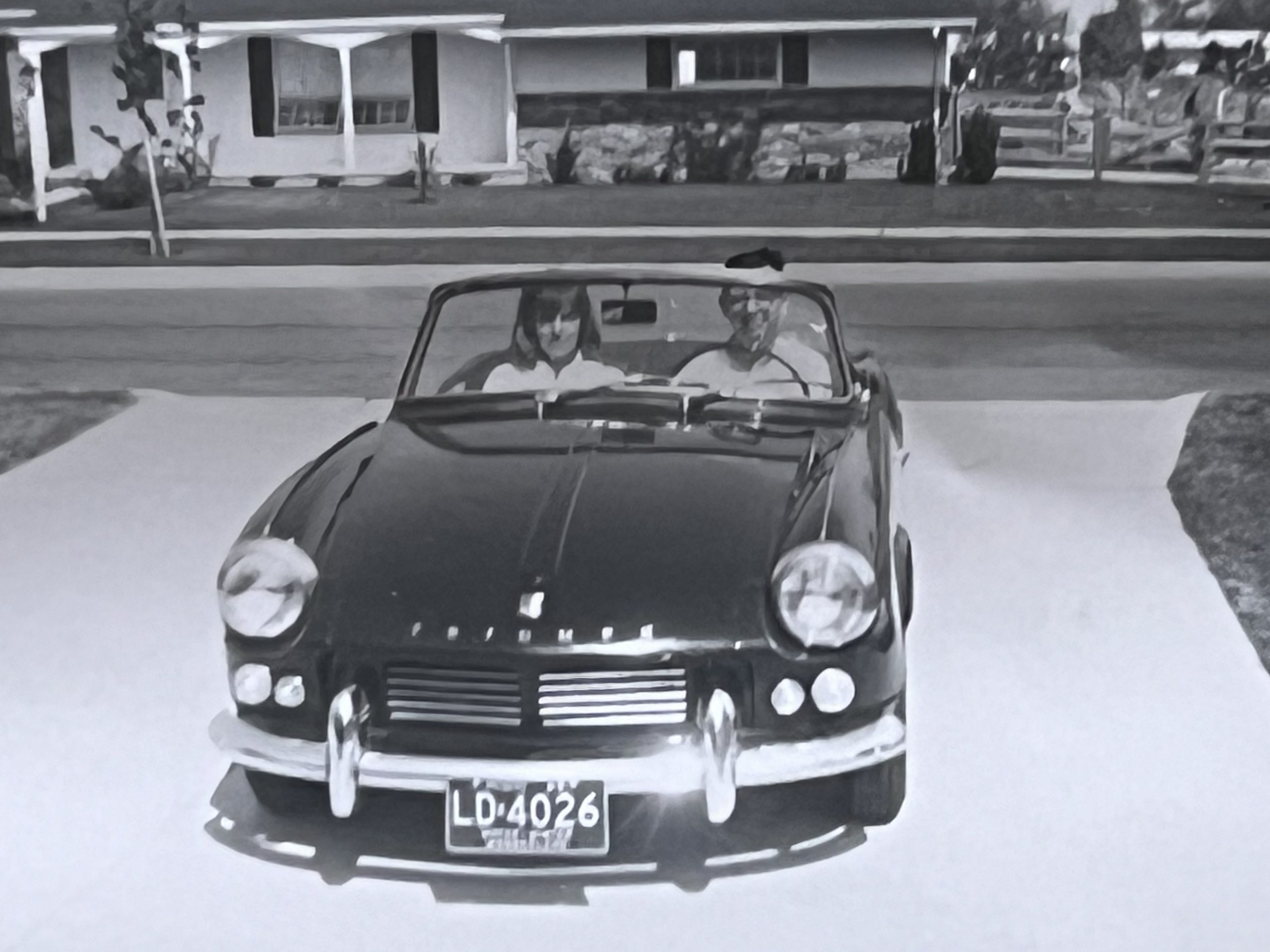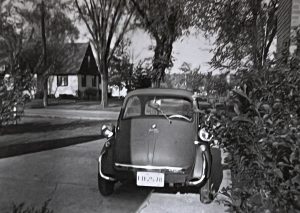
My high school boyfriend was captivated by cars. He could name every car on the road and had opinions about each one. I assumed it was one of those boy things that he was born with, like a fascination with machines or sports stats, and I passively absorbed from him the ability to pick out Mustangs and Toronados and GTO’s of different years. But the appreciation of cars didn’t stick around after the boyfriend was gone, and I have to admit to a lifelong diffidence regarding cars.
I needed something more reliable. My hours were irregular, public transportation spotty, and I lived too far from the hospital to walk. And it rained and snowed. Any car that ran would do. That, plus my general ambivalence, is probably why my first car was such a clunker.
Maybe I got that from my mother, since my father had a bit more interest. I think we had a Ford early on, that got totaled in a car accident in 1953, from which we all survived but retained scars. In Vietnam, my father found a used Hillman convertible that was kind of jaunty, and then unintentionally won a lottery for a big Oldsmobile someone was leaving behind when their tour of duty was over. The big black behemoth held the whole family well but had a habit of breaking down on longer trips, leaving us to scramble for repairs and alternate ways to get home from the countryside on the way to Dalat or Nha Trang.
When we moved from Vietnam back to East Lansing in 1959, he found out that it was possible to pick up a car in Europe and have it shipped back to the US at a great savings. So he arranged for us to get a Mercedes 180 sedan at the Stuttgart factory, which we drove around France before circling back and putting it on a ship at Bremen. The plan worked well except for the part about driving around in relatively recent post-war France in a German car, with German plates, full of a German-appearing family. Oops. We got ”V” signs from people in the fields, and a notable thawing when we turned out to be Americans.
Back in Michigan, he turned us into a two-car family when he bought a used Izetta from someone at the university. Cue the eyeroll from my mother. It was a tiny and undoubtedly unsafe vehicle—the entire front of that car was the door, with just a bench seat for maximum two people or maybe three if children. No seat belts or child seats of course. Its main charm was that it was red, cute as a bug, and could drive on a sidewalk if needed after a Big Ten football game at Michigan State. It also brought home the Christmas tree one year, the stump sticking down through the little sunroof, held on by one of the kids, while the top of the tree stuck straight up.
When we returned to Michigan from our next posting overseas, my mother drove our sensible and boring manual transmission Dodge K car while my father splurged on a cute Triumph. It was terrifying on a highway in the fog as big trucks passed by, but he drove it for years until it became too hard to clamber in and out of the low-slung chassis.
In any case, I had neither the means nor need for a car of my own until I was twenty-seven and moved to Seattle for my family practice residency. I drove there from San Francisco in an old Rambler sedan with push-button transmission on its last legs/tires, gifted to me by my boyfriend of the day. It was a bit of a boat that took oil at every gas stop, but it made it all the way to Seattle, where I heard it met its final demise after I sold it for a dollar to a young would-be filmmaker who filmed going over a cliff.
I needed something more reliable. My hours were irregular, public transportation spotty, and I lived too far from the hospital to walk. And it rained and snowed. Any car that ran would do. That, plus my general ambivalence, is probably why my first car was such a clunker.
There was a gas crisis going on, and cars were lining up at the pumps to spend over $2.00 a gallon—unheard of! I needed something that wasn’t a gas hog and it had to be cheap. Someone mentioned that an Opel Kadet might be a good choice, and I found a used one in a classified ad that fit the bill. The kid who sold it to me accepted my $600. It was a white squareback with a touchy stick transmission on the floor, poor suspension, plastic seats and a few minor dents in the white paint. It had all the charm of a mobile tin can. I didn’t care.
What I did mind was that, come winter, there was no heat. I bundled up and accepted my lot with the crappy car and was just happy it got me back and forth the couple of miles to work. I didn’t have the time to take it on road trips anyway.
By the end of the three-year residency, the car finally died and wasn’t worth repairing. But before it did, it coughed up a small surprise. One day I was driving somewhere a bit further than usual and noticed a faint warmth coming from a vent. Could it be? I had been cursing the lack of a working heater for a couple of years but there it was—clear evidence that it wasn’t entirely dead after all! It was just so anemic and took so long to warm up that I had never even noticed it.
When I moved from Seattle back to the Bay Area at the end of the three-year residency, I took all the money I had scrimped together and bought a new Honda. Everything worked, for years. Although I can appreciate the allure of flashier vehicles to some extent, I still find that the most important features are practicality, reliability, economy and now low emissions. I finally sold my Honda the first year the Prius came out, and now drive electric. It is a bit sad that car culture has been promoted at the expense of saner and less environmentally-destructive transportation and urban design policies. I’m sure that there are better alternatives, and that machines can still be fun.




Thanx Khati for the tour thru your lifetime of cars and as always your amazing recall of chronology and detail!
And altho to me cars were just basic transportation and never sparked much interest, I do remember that my dad always bought Buicks.
And I confess I have a soft spot for the two cars I wrote about this week – the 1966 Mustang and the 2004 Ford T-Bird, the latter I still drive!
I also have soft spots for special cars, just not enough for me to buy or rent or lust after them. More like a detached appreciation. Sally is the one who gets me into them, along with other things I wouldn’t choose. Which is probably a good thing on balance.
Wonderful trip through your vehicular history, Khati. There are some really exotic ones in the mix. I love the image of your father driving his tiny Izetta on the sidewalk after a Big 10 football game!
In your comments to my story, we’ve discussed the problems with living in a winter climate with a car that has no heat (or we didn’t know how to get it turned on). And always adding oil, as the car reaches the end of its life- not great when one relies on it for transportation).
My next car after the Valiant was a front-wheel drive VW Rabbit, much more reliable and better in the snow. Still no AC and just crank windows. I didn’t have any money either.
Yes, I also noticed some similar themes in our car stories! I didn’t even think about the lack of power anything—or the luxury of AC—but of course those were unheard of. Now my E-car powers everything and even thinks on my behalf—sometimes too much. I thought of you and your deep connections to the motor city and dealerships with this prompt. I wondered if anyone else would remember the Toronado except those of us from the Oldsmobile Capital of the World, Lansing.
I would have expected your attitude about cars to be about what it is; that’s also my attitude. Like you, I knew since I was young more than a few males that seemed to have inherited the ability to spot cars and identify the make, model, and year–and I never had a clue how they developed that talent. Nor did I ever wish I had it.
I thought maybe you were going to find money in that Opel, not a surprising burst of heat! When I paid someone to take away my 1984 Honda Accord (around 2001), I forgot that I left something secret as well–a stash of quarters and other coins in a metal container, probably at least $8 or $10 worth. I hope someone lucked onto them. before the car got demolished.
Well, a hidden cache of cash would have been a pleasant surprise too. 8 or 10 dollars was quite a sum back in the day—I hope someone discovered your stash.
An Opel Kadet. Mine was red. Touchy stick shift? Si. I was living in Boston, 1974, bumming around living off meager savings. The shifting became so problematic I took it to a garage and the mechanic said it would cost $160 to fix. That was about a third of all the cash I had. I declined. The mechanic looked at me and said: “I ain’t gonna let you drive that car out of here like that because if you do, you’re going to die.” He fixed the car on the strength of my promise to pay him back. So, I got a job at a Paperback Booksmith. Worked two weeks, got paid, paid the mechanic and headed to DC to meet up with some friends who were moving to Tracy’s Landing, MD. Right on the Bay. Chicken necks off the dock for crabs. About a year and a half later, on my way to The Steamboat Landing where I was waiting tables, the Opel started to scream-literally. Smoke and steam shot out from under the hood. I pulled over onto the side of the road. When I got out and closed the door, the back window fell out. Had it towed away the next day. Practical, reliable, economical…and tenacious. A nifty little car.
Wow, you gave me a good laugh with all your little red Opel adventures. Like yours, mine did mostly keep going even when it was falling apart. Until it didn’t. My mechanic must have used duct tape and WD 40 to keep it on life support. Brings back memories of a generally more precarious time for me.
Wow, Khati, you have sure had yourself a unique collection of cars over the years! I enjoyed your storytelling journey of all of them! And I haven’t thouoght about Izettas in many years!
Glad you enjoyed the ride, so to speak. The Izetta was definitely unusual and really fun when we were kids. Not the usual fare for Michigan—my dad bought it second hand and I have no idea how the vehicle found its way to middle America.